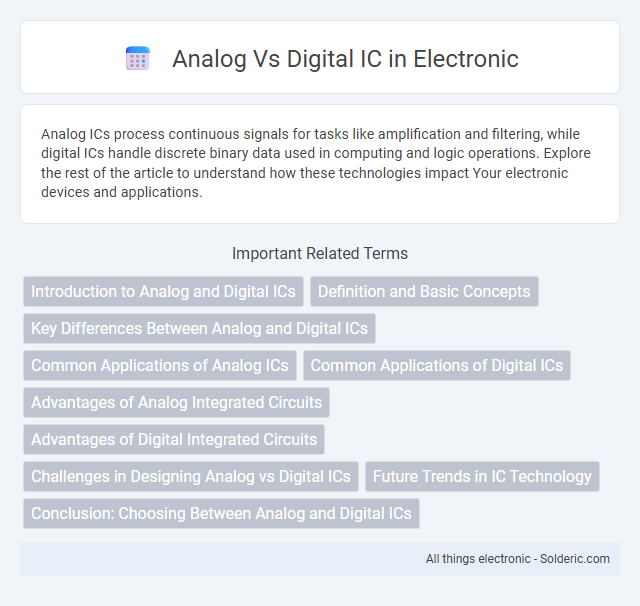Analog ICs process continuous signals for tasks like amplification and filtering, while digital ICs handle discrete binary data used in computing and logic operations. Explore the rest of the article to understand how these technologies impact Your electronic devices and applications.
Comparison Table
| Feature | Analog IC | Digital IC |
|---|---|---|
| Signal Type | Continuous analog signals | Discrete digital signals (0 and 1) |
| Operation | Amplifies or processes analog signals | Performs logical operations on binary data |
| Components | Transistors, capacitors, resistors | Logic gates, flip-flops, multiplexers |
| Precision | Limited by noise and distortion | High precision and noise immunity |
| Complexity | Less complexity for simple tasks | Handles complex operations efficiently |
| Power Consumption | Generally higher due to continuous operation | Lower power consumption in most cases |
| Applications | Audio amplifiers, sensors, RF circuits | Computers, microcontrollers, digital signal processors |
Introduction to Analog and Digital ICs
Analog ICs process continuous signals and are essential for applications involving real-world phenomena like temperature, sound, and voltage fluctuations. Digital ICs handle discrete signals, using binary code to perform complex computations and logic operations in devices such as microprocessors and memory chips. Understanding the fundamental differences in signal representation and processing methods is crucial for designing efficient electronic systems.
Definition and Basic Concepts
Analog ICs process continuous signals representing real-world phenomena like temperature or sound, using components such as resistors, capacitors, and transistors to amplify or filter these signals. Digital ICs handle discrete binary data, performing operations through logic gates and microprocessors to execute functions like computation and data storage. Understanding the fundamental difference between continuous analog signals and discrete digital signals helps you choose the right IC for applications requiring precision or digital control.
Key Differences Between Analog and Digital ICs
Analog ICs process continuous signals, allowing them to represent varying physical quantities such as temperature or sound, whereas digital ICs handle discrete binary signals that represent data in 0s and 1s. Your choice between analog and digital ICs depends on factors like signal processing requirements, power consumption, and noise tolerance, with analog ICs excelling in precision and digital ICs providing faster, more reliable data handling. Key differences include signal type, complexity, power efficiency, and application areas, making it crucial to understand these aspects for effective circuit design.
Common Applications of Analog ICs
Analog ICs are widely used in applications such as audio amplification, signal conditioning, and sensor interfacing, enabling precise control and processing of continuous signals. Common examples include operational amplifiers, voltage regulators, and analog-to-digital converters that enhance the performance of communication devices, medical instruments, and automotive systems. Your projects can benefit from the reliability and accuracy provided by analog ICs in measurement and control tasks where real-world signal integrity is crucial.
Common Applications of Digital ICs
Digital ICs are widely employed in microprocessors, memory devices, and digital signal processors, forming the backbone of modern computing systems. They are integral to digital communication systems, enabling data encoding, transmission, and error correction. Applications extend to consumer electronics, including smartphones, tablets, and digital cameras, where digital ICs manage processing, control, and interface functions.
Advantages of Analog Integrated Circuits
Analog integrated circuits offer superior performance in processing continuous signals with high accuracy and low latency, making them ideal for applications like audio amplification and sensor interfacing. They provide excellent noise immunity and power efficiency, often resulting in lower overall system cost and complexity compared to digital counterparts. The inherent simplicity of analog ICs allows seamless integration with the physical world, enhancing signal fidelity in real-time processing tasks.
Advantages of Digital Integrated Circuits
Digital integrated circuits offer precise signal processing with high noise immunity, ensuring reliable performance even in complex electronic systems. They enable easy scalability and programmability, allowing your designs to adapt quickly to evolving technological requirements. Their lower power consumption and cost-effectiveness make them ideal for mass production and compact devices.
Challenges in Designing Analog vs Digital ICs
Designing analog ICs involves challenges such as managing noise, process variations, and temperature sensitivity, which require precise component matching and careful layout techniques. Digital IC design primarily faces complexity in timing closure, power optimization, and scalable integration of millions of transistors. Achieving reliable analog performance demands intricate modeling of device physics, while digital design focuses on logic synthesis and fault tolerance.
Future Trends in IC Technology
Future trends in IC technology emphasize the integration of analog and digital circuits to enhance performance and reduce power consumption in complex systems. Advances in semiconductor materials like gallium nitride and silicon carbide enable higher frequency operation and improved thermal management for both analog and digital ICs. Emerging applications such as artificial intelligence, 5G communications, and IoT drive demand for highly efficient mixed-signal ICs with increased miniaturization and enhanced signal processing capabilities.
Conclusion: Choosing Between Analog and Digital ICs
Choosing between analog and digital ICs depends on the specific application requirements, such as signal type, accuracy, and complexity. Analog ICs excel in processing continuous signals with high precision, while digital ICs offer better noise immunity and flexibility for complex operations. Your decision should align with performance needs, power consumption, and integration level to optimize system functionality.
Analog vs Digital IC Infographic

 solderic.com
solderic.com